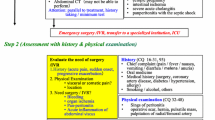Abstract
Background
This study aimed to review our decade-long experience with the management of abdominal gunshot wounds (GSWs), to document trends in our approach and to develop an evidence base for our contemporary management algorithms in a major trauma in South Africa.
Materials and methods
This was a retrospective study that included all adult patients with abdominal GSWs between January 2013 and October 2020 managed at a major trauma centre in South Africa.
Result
Five hundred and ninety-six cases were included (87% male, mean age: 32 years). The median Injury Severity Score (ISS) was 12. 52% (309/596) of cases had indications of immediate laparotomy and proceeded directly to the operating room without any CT imaging. Of this cohort, the laparotomy was positive in 292 and in the remainder (5%) was negative. Of the remaining 287 cases, 209 underwent a CT scan (35%). 78 were managed without any CT imaging. Of the 78 who did not undergo CT scan, all were managed without any operation and discharged home well. Of the 209 who underwent CT scan, 99 were observed and only one case in this group subsequently required a laparotomy. The remaining 110 cases underwent a laparotomy, which was negative in 7. There were correlations with increasing use of CT, as well as a decrease in those proceeding directly to laparotomy. The overall morbidity rate was 8% (47/596). 32% (190/596) require intensive care unit (ICU) admission. The overall mortality rate was 8% (67/596).
Conclusions
The management of abdominal GSWs has continued to evolve. There is now a well-defined role for selective non-operative management in this group of patients and relies on accurate CT assessment. CT scan is now an important component in the management of abdominal GSW even in our resource-constrained environment.






Similar content being viewed by others
References
Demetriades D, Hadjizacharia P, Constantinou C et al (2006) Selective nonoperative management of penetrating abdominal solid organ injuries. Ann Surg 244(4):620–628
Muckart DJ, Abdool-Carrim AT, King B (1990) Selective conservative management of abdominal gunshot wounds: a prospective study. Br J Surg 77(6):652–655
Omoshoro-Jones JA, Nicol AJ, Navsaria PH (2005) Selective non-operative management of liver gunshot injuries. Br J Surg 92(7):890–895
Navsaria PH, Nicol AJ, Krige JE et al (2009) Selective nonoperative management of liver gunshot injuries. Ann Surg 249(4):653–656
Velmahos GC, Constantinou C, Tillou A et al (2005) Abdominal computed tomographic scan for patients with gunshot wounds to the abdomen selected for nonoperative management. J Trauma 59(5):1155–1160
Lowe RJ, Salietta JD, Read DR et al (1977) Should laparotomy be mandatory or selective in gunshot wounds of the abdomen? J Trauma 17:903–907
Demetriades D, Gomez H, Chahwan S (1999) Gunshot injuries to the liver: the role of selective nonoperative management. J Am Coll Surg 188(4):343–348
Demetriades D, Velmahos G, Cornwell E et al (1997) Selective nonoperative management of gunshot wounds of the anterior abdomen. Arch Surg 132(2):178–183
Chmielewski GW, Nicholas JM, Dulchavsky SA et al (1995) Nonoperative management of gunshot wounds of the abdomen. Am Surg 61(8):665–668
Renz BM, Feliciano DV (1995) Unnecessary laparotomies for trauma: a prospective study of morbidity. J Trauma 38:350–356
Velmahos GC, Demetriades D, Toutouzas KG et al (2001) Selective nonoperative management in 1,856 patients with abdominal gunshot wounds: should routine laparotomy still be the standard of care? Ann Surg 234(3):395–403
Ginzburg E, Carrillo EH, Kopelman T, McKenney MG, Kirton OC, Shatz DV, Sleeman D, Martin LC (1998) The role of computed tomography in selective management of gunshot wounds to the abdomen and flank. J Trauma 45(10051009):13
Grossman MD, May AK, Schwab CW, Reilly PM, MacMahon DJ, Rotondo M, Shapiro MB, Kauder DR, Frankel H, Anderson H III (1998) Determining anatomic injury with computed tomography in selected torso gunshot wounds. J Trauma 45:446–456
Múnera F, Morales C, Soto JA et al (2004) Gunshot wounds of abdomen: evaluation of stable patients with triple-contrast helical CT. Radiology 231(2):399–405
Al Rawahi AN, Al Hinai FA, Boyd JM, Doig CJ, Ball CG, Velmahos GC, Kirkpatrick AW, Navsaria PH, Roberts DJ (2018) Outcomes of selective nonoperative management of civilian abdominal gunshot wounds: a systematic review and meta-analysis. World J Emerg Surg 27(13):55
Navsaria PH, Nicol AJ, Edu S et al (2015) Selective nonoperative management in 1106 patients with abdominal gunshot wounds: conclusions on safety, efficacy, and the role of selective CT imaging in a prospective single-center study. Ann Surg 261(4):760–764
DuBose J, Inaba K, Teixeira PG et al (2007) Selective non-operative management of solid organ injury following abdominal gunshot wounds. Injury 38(9):1084–1090
Donovan MM, Kong VY, Bruce JL, Laing GL, Bekker W, Manchev V, Smith M, Clarke DL (2019) The hybrid electronic medical registry allows benchmarking of quality of trauma care: a five-year temporal overview of the trauma burden at a major trauma centre in South Africa. World J Surg 43(4):1014–1021
Author information
Authors and Affiliations
Corresponding author
Ethics declarations
Conflict of interest
The author declares there is no conflict of interest.
Additional information
Publisher's Note
Springer Nature remains neutral with regard to jurisdictional claims in published maps and institutional affiliations.
Rights and permissions
About this article
Cite this article
Lee, H., Kong, V., Cheung, C. et al. Trends in the Management of Abdominal Gunshot Wounds Over the Last Decade: A South African Experience. World J Surg 46, 998–1005 (2022). https://doi.org/10.1007/s00268-022-06469-1
Accepted:
Published:
Issue Date:
DOI: https://doi.org/10.1007/s00268-022-06469-1




